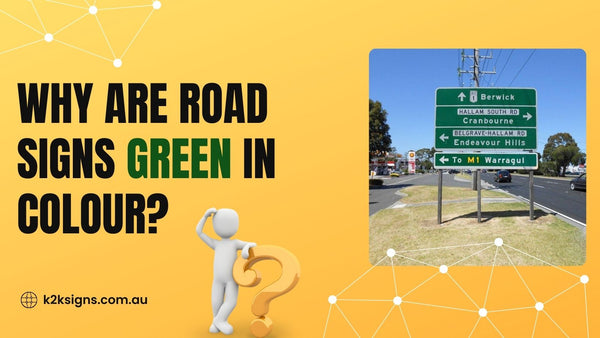Why Are Road Signs Green in Colour?
Back in the early days of road signs, when cars first started sharing the roads with horse-drawn carriages and pedestrians, people needed a way to communicate important information to drivers.
They realised that the signs needed to be highly visible against the natural backdrop of trees, grass, and other scenery.

After experimenting with different colours, they settled on green because it starkly contrasted the surrounding environment, making it easy for drivers to spot.
Below are some more reasons why road signs are green in colour.
Visibility and Contrast
When driving down a road lined with trees or surrounded by grass fields, it can sometimes be challenging to see signs that blend in with the scenery. Imagine if red or blue road signs might stand out less against the greenery.
But green signs? They practically shout for attention! Green contrasts sharply with the natural colours of the landscape, making it much easier for drivers to see and understand the information they convey.
International Standards
As more and more people began to travel between different regions and countries, transportation authorities realised the importance of having consistent road sign colours to ensure universal understanding.
Over time, international standards were established, recommending or even mandating the use of green for certain types of signs. This standardised approach helps drivers easily navigate unfamiliar roads, regardless of where they are in the world.
Psychological Impact
Believe it or not, colours can profoundly affect our emotions and perceptions. Green is often associated with safety, growth, and nature.
When drivers see green road signs, it triggers a subconscious response that signals caution and attentiveness. This psychological impact helps reinforce the importance of paying attention to the information displayed on the signs, ultimately contributing to safer driving practices.
Consistency and Recognition
Imagine driving through a city where every road sign was a different colour - it would be incredibly confusing! Transportation authorities ensure consistency and facilitate quick recognition by using green for certain types of signs, such as directional signs or highway exits.
Drivers can instantly identify the type of information conveyed based on the sign's colour, making navigation much smoother and more efficient.
Regulatory Requirements
In many countries, strict regulations govern the design and colour of road signs. These regulations are implemented to standardise signage across different regions and ensure maximum clarity and safety for drivers.
Green has been designated as the standard colour for certain signs in many jurisdictions, helping maintain uniformity and avoid confusion on the roads.
Technological Advancements
Thanks to advancements in materials and manufacturing techniques, modern road signs are more durable and reflective than ever before.
Reflective coatings and materials ensure that signs remain highly visible, even in low-light conditions or during inclement weather. This increased visibility enhances safety for drivers, allowing them to spot and read signs from a distance easily.
Alternative Approaches
While green has proven to be the most effective colour for road signs in many situations, there have been occasional experiments with alternative colour schemes. However, these experiments have typically decreased visibility or confusion among drivers.
As a result, green remains the preferred choice for most road signs, providing optimal visibility and clarity for drivers on the road.
Cultural and Regional Variations
Despite the widespread adoption of green for road signs, some cultural and regional variations in signage practices exist. In certain areas, local preferences or historical traditions may influence the colour choices for road signs.
However, these variations are usually minor and do not significantly impact the overall effectiveness of signage systems.
Future Trends
Looking ahead, advancements in technology and design may continue to shape the future of road signage. From interactive digital displays to augmented reality overlays, there needs to be a telling what innovative solutions may emerge to enhance driver safety and navigation.
However, one thing is certain - green will likely remain a staple colour for road signs, thanks to its unparalleled visibility and universal recognition.

